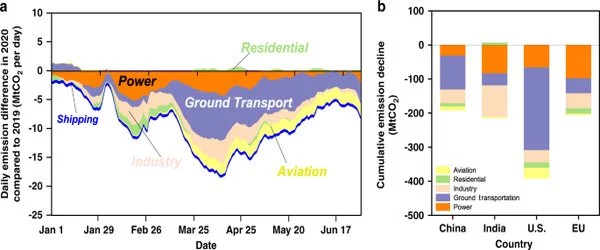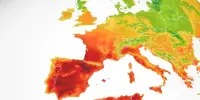Changes in human activities caused by the COVID-19 pandemic influenced global energy consumption and CO2 emissions, but many details about these effects remain unknown. In addition to the significant differences, annual national inventories of energy and fuel use, which have traditionally been used to assess CO2 emissions, lag reality by 1 or 2 years and are thus not yet available to assess the COVID-19 impacts.
Sharp drops in transportation emissions during COVID-19 lockdowns may explain why a key greenhouse gas reached record levels in 2020, according to new research. The study discovered that reduced emissions from road transport, railways, and planes during lockdowns accounted for more than half of the 50% increase in methane growth rate between 2019 and 2020.
Reduced transportation emissions resulted in lower levels of another gas known as the hydroxyl radical, which acts like a detergent to remove methane from the atmosphere, according to researchers. Until now, the causes of the 2020 methane spike—second only to carbon dioxide as a driver of climate change—were unknown.
Previous research suggested that the rise was caused in part by increased natural emissions from tropical wetlands.
A team led by an Edinburgh scientist studied how lockdown emission changes affected methane levels using global atmospheric chemistry models. In 2020, these increased by a record 15 parts per billion (ppb), up from 9.7 ppb in 2019. Previous research estimates that global nitrogen oxide, carbon monoxide, and other transportation-related emissions will be reduced by 10-20% by 2020.
Understanding why methane is increasing so quickly is critical for developing climate change policies. The recent increase in methane growth rate is concerning, but a large portion of the increase in 2020 is likely due to reduced emissions of other gases, particularly nitrogen oxides from transportation, during COVID-19 lockdowns.
Professor David Stevenson
Methane surge
The team’s findings suggest that, of the total 5.3 ppb rise in methane growth rate in 2020, reduced transport emissions led to a 2.9 ppb increase. Reductions in nitrogen oxides led to a 4.8 ppb increase that year, while reductions in carbon monoxide and other chemicals had the opposite effect, reducing methane growth by 1.9 ppb.
Around 30% of the increase in methane in 2020 was caused by lower nitrogen oxide emissions from aviation, which fell by more than one-fifth globally.

Lockdown changes
According to the team, more research into how the atmosphere’s composition changed during lockdowns will help scientists better understand past methane changes and improve future projections. The Natural Environment Research Council and the Royal Society funded the research, which was published in the journal Atmospheric Chemistry and Physics. It also included researchers from the Universities of Reading and Lancaster.
“Understanding why methane is increasing so quickly is critical for developing climate change policies. The recent increase in methane growth rate is concerning, but a large portion of the increase in 2020 is likely due to reduced emissions of other gases, particularly nitrogen oxides from transportation, during COVID-19 lockdowns.”
“The lockdowns provide us with a unique opportunity to better understand methane behavior.” Continued growth in 2022 is unlikely to be explained by this mechanism, implying that something else is going on. Slowing, and eventually reversing, methane growth necessitates dramatic and rapid reductions in methane emissions, as outlined in key pledges made at COP26 in Glasgow. These must be implemented and strengthened as soon as possible” says Professor David Stevenson.
















